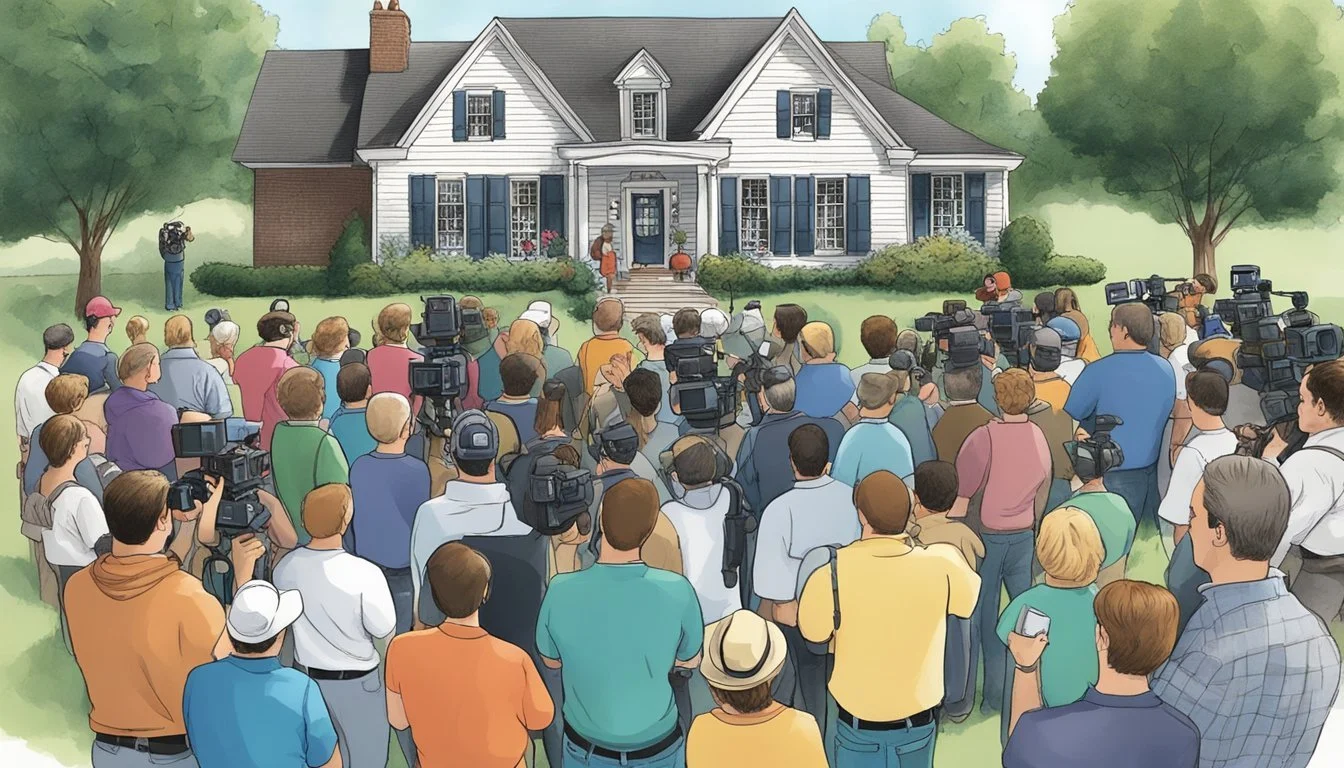Inside the Infamous JonBenét Ramsey Home: The Dark Legacy of a Murdered Child's Mansion!
The JonBenét Ramsey home in Boulder, Colorado remains one of America's most infamous crime scenes. Located on 15th Street in an affluent neighborhood, this red brick mansion was where 6-year-old JonBenét was tragically found murdered on December 26, 1996. The property has been listed for sale multiple times since the crime, most recently with an asking price of nearly $7 million.
Over the years, the home has undergone extensive renovations in attempts to distance it from its dark past. New owners have made significant changes to the interior layout and decor. Despite these efforts, the property continues to attract attention due to its connection to the unsolved murder case that captured national headlines.
The Ramsey home's history reflects the lasting impact of the tragedy on both the property and the community. While some potential buyers may be drawn to its notoriety, others struggle to look past the events that occurred there. The house stands as a somber reminder of a young life lost and a mystery that remains unsolved decades later.
Background History
The JonBenét Ramsey case captivated the nation, unfolding against the backdrop of an affluent Boulder, Colorado neighborhood. The Ramsey family's profile, JonBenét's brief life, and the local community all played crucial roles in shaping this tragic event.
The Ramsey Family Profile
John and Patsy Ramsey moved to Boulder in 1991 with their children Burke and JonBenét. John, a successful businessman, was president of Access Graphics. Patsy, a former beauty queen, dedicated herself to her family and community involvement.
The Ramseys lived in a 7,000-square-foot Tudor-style home on 15th Street, valued at nearly $7 million in recent years. Their affluent lifestyle and social connections made them well-known figures in Boulder.
JonBenét Ramsey: A Brief Biography
JonBenét Patricia Ramsey was born on August 6, 1990, in Atlanta, Georgia. She gained recognition in child beauty pageants, winning several titles.
At six years old, JonBenét attended Martin Park Elementary School in Boulder. She was known for her outgoing personality and talent in performance.
Tragically, JonBenét's life was cut short on December 26, 1996, when she was found murdered in her family's home basement.
The Boulder, Colorado Community
Boulder, home to the University of Colorado, was known for its scenic beauty and progressive atmosphere. In 1996, it had a population of about 90,000 residents.
The city boasted low crime rates and a strong sense of community. The Ramsey case shocked residents, challenging their perception of safety.
The Boulder Police Department, inexperienced with high-profile murder cases, faced intense scrutiny during the investigation. The case strained relationships between law enforcement and the community.
The Ramsey Residence
The Ramsey residence in Boulder, Colorado gained notoriety as the site of JonBenét Ramsey's tragic murder in 1996. This Tudor-style mansion, located at 749 15th Street, features distinctive architectural elements and a spacious layout spread across multiple floors.
Architectural Overview of the Ramsey Home
The Ramsey home is a striking Tudor-style mansion with red brick exterior walls and decorative half-timbering. Its steep gabled roofs and large windows are characteristic of the Tudor revival architecture popular in affluent American neighborhoods.
The property spans 11,376 square feet, making it one of the larger homes in the area. Multiple chimneys and dormer windows add visual interest to the roofline.
A grand entrance with a heavy wooden door welcomes visitors into the foyer. The home's exterior exudes a sense of old-world charm combined with modern luxury.
Interiors and Layout
Inside, the Ramsey residence boasts an expansive floor plan designed for both comfort and entertaining. The first floor features a spacious living room with a fireplace, a formal dining room, and a gourmet kitchen equipped with high-end appliances.
A wine cellar provides storage for the family's collection. The second floor houses several bedrooms, including a luxurious master suite.
Large windows throughout the home allow ample natural light to fill the spaces. The interior design, at the time of the incident, reflected a blend of traditional and contemporary styles.
Real Estate Value and Significance
The Ramsey home's real estate value has fluctuated over the years, influenced by both market trends and its infamous history. In 2023, the property was listed for sale with an asking price of $6.24 million.
Despite its tragic past, the home remains a valuable piece of real estate due to its size, location, and architectural merit. The Boulder housing market has generally seen appreciation over time, further boosting the property's worth.
The home's notoriety has made it a subject of interest for true crime enthusiasts and real estate investors alike. Its value extends beyond mere square footage, encompassing its place in American criminal history.
JonBenét Ramsey's Murder
The murder of JonBenét Ramsey on December 26, 1996 shocked the nation and remains one of America's most infamous unsolved crimes. The 6-year-old beauty queen was found dead in the basement of her family's Boulder, Colorado home.
The Tragic Event and Immediate Aftermath
JonBenét's mother Patsy Ramsey called 911 early on December 26th to report her daughter missing. She claimed to have found a ransom note demanding $118,000 for JonBenét's return.
Police arrived and searched the house but initially found no sign of the girl. Hours later, JonBenét's father John Ramsey discovered her body in the basement wine cellar.
The young girl had been strangled with a garrote and suffered a skull fracture. The brutal nature of the crime in the family's own home sent shockwaves through the community.
Investigation Details
The Boulder Police Department faced criticism for their handling of the case. Key missteps included:
Failure to properly secure the crime scene
Allowing friends and family to move freely through the house
Not separating the parents for questioning
These errors complicated evidence collection and witness interviews. As the investigation dragged on, suspicion fell on JonBenét's parents and brother, though they maintained their innocence.
Evidence and Key Locations
The Ramsey home became central to the investigation. Key evidence included:
The ransom note, written on paper from the home
DNA evidence found on JonBenét's clothing
The basement where her body was discovered
Investigators focused on the wine cellar and other areas of the 7,000 square foot house. Despite extensive forensic analysis, no definitive suspect was identified.
The case remains open, with periodic reviews of evidence using new technology. The murder of JonBenét Ramsey continues to captivate the public as one of America's most perplexing cold cases.
Public Response and Media Coverage
The JonBenét Ramsey case captivated the public and dominated news cycles for years. Intense scrutiny from journalists and true crime enthusiasts sparked widespread debate and speculation about the circumstances surrounding her death.
Media's Role in the JonBenét Ramsey Case
Newspapers, television networks, and tabloids devoted extensive coverage to the murder investigation. Journalists descended on Boulder, Colorado, conducting interviews and digging for exclusive information. The 24-hour news cycle amplified every development, no matter how small.
Sensationalized headlines and unverified claims became common. Some outlets published leaked details from the crime scene and autopsy report. This led to criticism of media ethics and concerns about compromising the investigation.
The case launched numerous television specials, books, and magazine features. Experts and amateur sleuths offered conflicting theories about potential suspects and motives.
Public Interest and Speculation
JonBenét's pageant background and the mysterious ransom note fueled public fascination. Online forums and chat rooms buzzed with theories and debates. Some speculated about intruder scenarios, while others suspected family involvement.
The lack of arrests led to widespread frustration and amateur detective work. Armchair sleuths pored over case details, crime scene photos, and witness statements. This resulted in a mix of legitimate analysis and baseless rumors.
Public opinion shifted over time as new information emerged. Initial sympathy for the Ramsey family gave way to suspicion in some quarters.
Documentaries and True Crime Features
Numerous documentaries and TV specials explored the JonBenét Ramsey case. These productions often featured interviews with investigators, journalists, and family friends. Some programs focused on specific theories or suspects.
Notable examples include:
"The Case of: JonBenét Ramsey" (CBS, 2016)
"Casting JonBenét" (Netflix, 2017)
"The Killing of JonBenét: The Truth Uncovered" (A&E, 2016)
These shows aimed to shed new light on the investigation or offer fresh perspectives. Critics argued that some programs prioritized sensationalism over factual reporting.
Impact on the Ramsey Family
The intense media scrutiny took a heavy toll on John, Patsy, and Burke Ramsey. They faced constant questions from reporters and judgmental looks from the public. The family's every move was analyzed and debated in the press.
Patsy Ramsey, in particular, became a target of speculation. Her behavior and statements were dissected by amateur profilers and body language experts. This led to significant stress and emotional trauma for the grieving mother.
Burke Ramsey, JonBenét's brother, grew up under a cloud of suspicion. As an adult, he filed lawsuits against media outlets for defamation. The family's attempts to maintain privacy were often thwarted by persistent media interest.
Legacy and Impact
The JonBenét Ramsey case left an indelible mark on American culture and society. Its reverberations continue to shape public discourse on child safety and criminal investigations.
JonBenét's Influence on Child Beauty Pageants
JonBenét's participation in child beauty pageants sparked intense debate about these events. Many critics argued that such pageants sexualized young children and put them at risk.
As a result, several states considered banning child beauty pageants. While few outright bans were enacted, stricter regulations emerged in some areas.
The pageant industry faced increased scrutiny and saw declining participation in the years following the case. Some pageants implemented new safety measures and age restrictions.
JonBenét's story also prompted broader discussions about child exploitation and the pressure placed on young children to grow up too quickly.
The Enduring Mystery of the Case
The unresolved nature of JonBenét's murder has kept it in the public eye for decades. True crime enthusiasts continue to analyze evidence and propose new theories.
The case exposed flaws in the initial police investigation, leading to changes in how law enforcement handles high-profile crimes. Many departments now use specialized teams for child homicides.
DNA technology advancements have periodically reignited interest in the case. Investigators have revisited evidence multiple times, hoping new techniques might yield a breakthrough.
The Ramsey house itself became a symbol of the tragedy. Its repeated appearances on the real estate market serve as reminders of the unsolved crime that occurred within its walls.
Local and Cultural References
The JonBenét Ramsey case left an indelible mark on Boulder, Colorado. It intertwined with local institutions, real estate trends, and creative works inspired by the events.
University of Colorado Boulder's Role in the Community
The University of Colorado Boulder, a prominent local institution, played a peripheral role in the Ramsey case. Some faculty members provided expert analysis during the investigation. The university's criminology department used the case as a study subject in forensic courses.
CU Boulder's presence significantly shapes Boulder's demographics and economy. Many students and staff live in the University Hill neighborhood, not far from the Ramsey home. The influx of students each year impacts local housing demand and rental markets.
Boulder's Real Estate and Housing Dynamics
Boulder's housing market has evolved since the Ramsey case. The city's desirability and limited space drove up property values. The Ramsey house, once valued around $500,000, later listed for over $6 million.
Boulder implemented strict growth limits, preserving open spaces but constraining housing supply. This policy contributed to rising home prices. The median home value in Boulder now exceeds $1 million, pricing out many residents.
The Ramsey case temporarily affected nearby property values. However, Boulder's strong economy and natural beauty maintained its real estate appeal long-term.
The Ramsey Home in Cultural Works
The JonBenét Ramsey case inspired numerous books, documentaries, and TV shows. Many featured the Ramsey home prominently. The house became a symbol in true crime narratives.
Several works explored the home's layout and its role in the investigation. Documentaries often showed exterior shots of the property. Some books included floor plans to aid readers in understanding the crime scene.
The case's cultural impact extended beyond true crime. It sparked discussions about child beauty pageants and media sensationalism. The Ramsey home, as the crime scene, remained a focal point in these broader cultural conversations.
Additional Connections
The JonBenét Ramsey home attracted interest from individuals with ties to prominent religious organizations. These connections added new layers to the property's history after the tragic events of 1996.
Carol Schuller Milner and Timothy Milner
Carol Schuller Milner, daughter of televangelist Robert Schuller, and her husband Timothy Milner purchased the Ramsey home in 2004. The couple paid $1.05 million for the property, intending to restore it and create a safe haven for young people.
Carol and Timothy lived in the house for several years with their children. They made renovations and worked to move past the home's dark history. However, financial difficulties led them to put the property back on the market in 2008.
The Crystal Cathedral and Hour of Power
Carol Schuller Milner's connection to the Crystal Cathedral and Hour of Power TV program brought a unique perspective to the Ramsey home. Her father, Robert Schuller, founded both the church and the popular television ministry.
The Crystal Cathedral, known for its striking glass architecture, was a landmark in Garden Grove, California. Hour of Power broadcast services from the cathedral to millions of viewers worldwide.
Carol's experience growing up in a high-profile religious family likely influenced her approach to the Ramsey property. Her goal of transforming the home into a positive space for youth aligned with her family's ministry background.




